DART Bonneville "Quick Look" Adult Spring Chinook Passage with River Environment and Historical Run Timing
Data Courtesy of U.S. Army Corps of Engineers, NWD
Bonneville Spring Chinook (3/1-6/15) Project Summary
www.cbr.washington.edu/dart/query/adult_proj_sum

| Species | Date Range | 2025 YTD Passage |
2024 YTD Passage |
Percent of YTD 2024 |
2021 - 2024 YTD 4 Year Avg |
Percent of YTD 4 Year Avg |
2015 - 2024 YTD 10 Year Avg |
Percent of YTD 10 Year Avg |
Run Complete2 |
2015 - 2024 Total 10 Year Avg |
2015 - 2024 Run Timing |
Cumulative Passage with 4 Year Avg and 10 Year Avg |
4 Years Rolling Mean All Years |
|---|---|---|---|---|---|---|---|---|---|---|---|---|---|
| Chinook | Mar - Dec | 9589 | 7672 | 124 % | 6625 | 144 % | 13900 | 68 % | 640524 | Graph | Graph | Run Size Arithmetic | 50% Passage Geometric | |
| Spring Chinook | 3/15 - 5/31 | 9589 | 7667 | 125 % | 6622 | 144 % | 12586 | 76 % | 105459 | Graph | Graph | Run Size Arithmetic | 50% Passage Geometric | |
| Spring Chinook Forecast Dates | 3/15 - 6/15 | 9589 | 7667 | 125 % | 6622 | 144 % | 12586 | 76 % | 131334 | Graph | Graph | Run Size Arithmetic | 50% Passage Geometric | |
| Spring/Summer Chinook | 3/15 - 7/31 | 9589 | 7667 | 125 % | 6622 | 144 % | 12586 | 76 % | 194107 | Graph | Graph | Run Size Arithmetic | 50% Passage Geometric |
- Data Courtesy of U.S. Army Corps of Engineers.
- Month ranges represent the expected date range of passage for the species, estimated from the previous year's passage dates. Explicit date ranges limit the counts to that specific date range. The Chinook Run schedules are reported by USACE, ODFW and the YKFP.
- The Run Complete date is the last non-zero date of passage when the species has met the run complete criteria: 2 weeks (14 days) of zero passage for the species.
- Shaded rows represent subpopulations of the species as a whole.
- Last possible Data Date included is 04/24/2025.
- The 10 (or N) Year Averages are calculated by DART for each calendar day of data at each project. For the current year and any given project/month/day, the data from the previous 10 years on that calendar day is summed and divided by the number of non-null data points available. Calendar day averaging was chosen because, historically, data observations begin on a specific calendar day. Calendar day averaging gives different results than day of year averaging. YTD Averages and Total Averages presented in this report are the sum of the calendar day averages.
- View the Daily 2025 Bonneville Adult Passage counts.
- Click on a Species followed by the symbol to view the DART Adult Passage Data Inventory for the Species at Bonneville for all years, including: number of data points, day range of data, and annual count.
Bonneville Spring Chinook (3/15-6/15) Adult Passage current year with 10 Year Average
www.cbr.washington.edu/dart/query/adult_graph_text
www.cbr.washington.edu/dart/query/river_graph_text
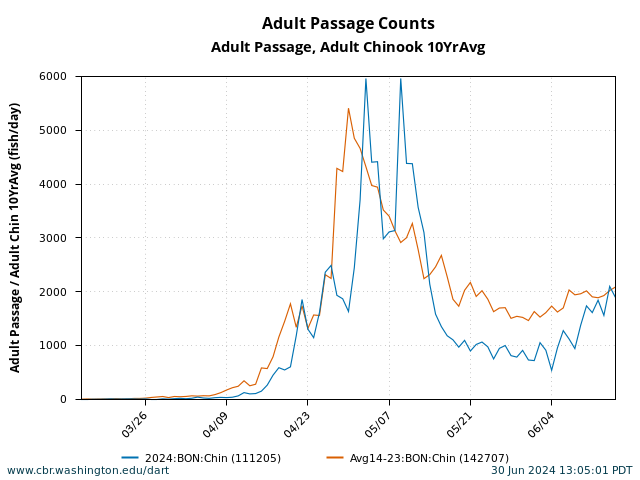
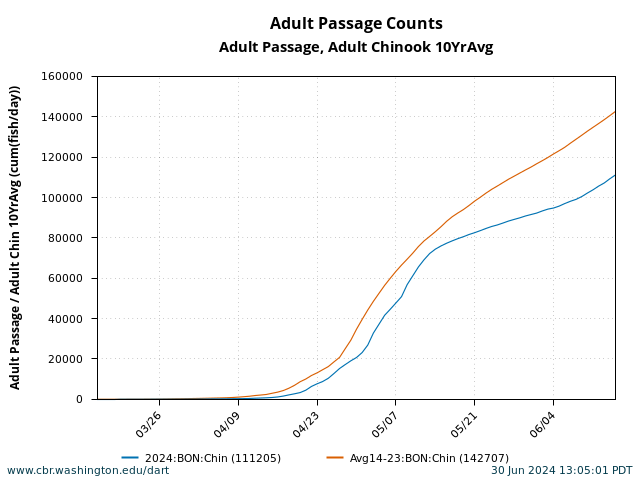
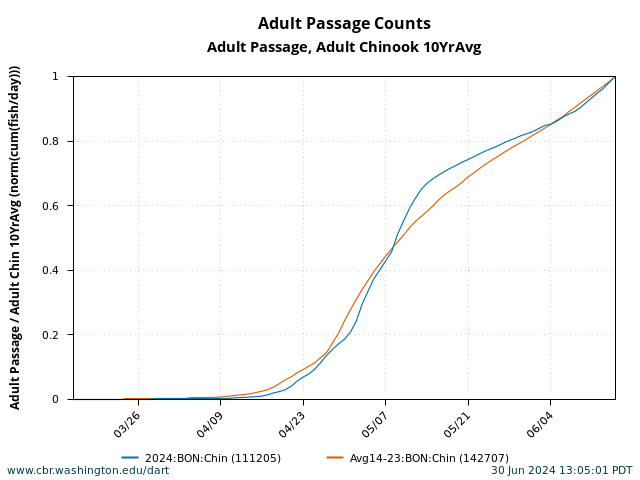
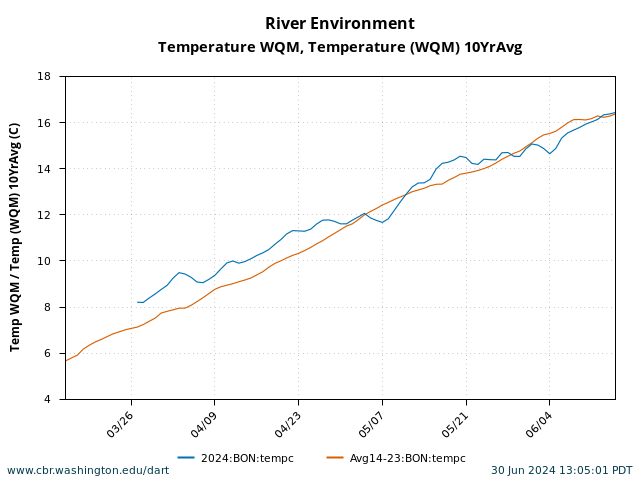
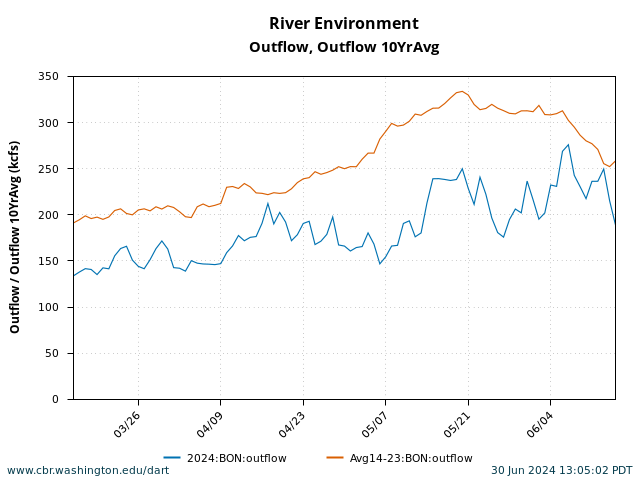
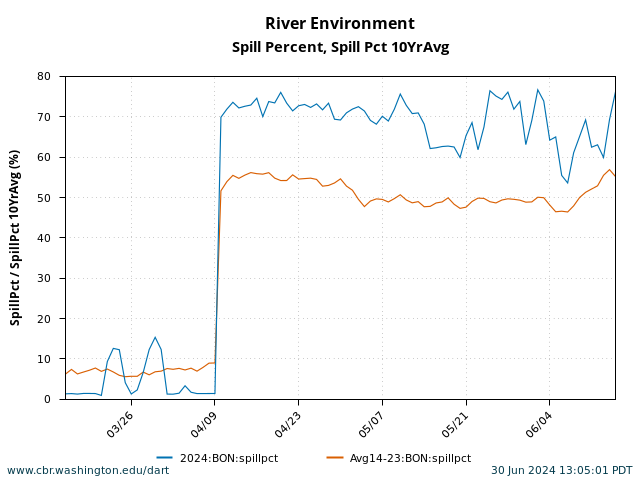
Bonneville Spring Chinook (3/15-6/15) Historical Migration Timing Characteristics
www.cbr.washington.edu/dart/query/adult_hrt
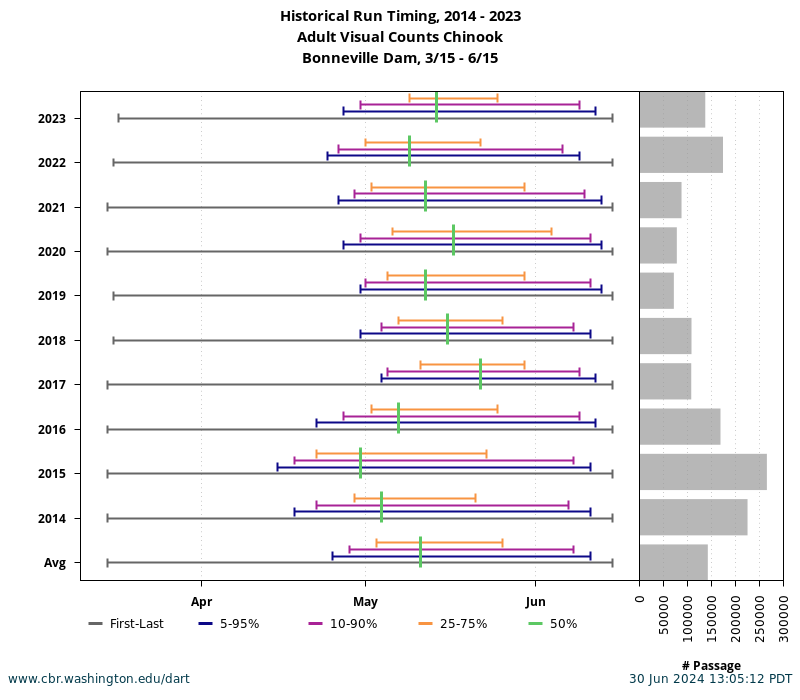
| Year | Passage Dates | Duration Middle 80% Days |
Duration Middle 50% Days |
Duration Middle 90% Days |
Run Size | "Today" (04/25) Passage % |
View Data | Water Supply NWRFC,NOAA Apr-Sep Pct Normal |
||||||||
|---|---|---|---|---|---|---|---|---|---|---|---|---|---|---|---|---|
| First | 5% | 10% | 25% | 50% | 75% | 90% | 95% | Last | ||||||||
| 2025 1 YTD | 03/15 | 04/24 | 9589 (YTD) | Graph Table |
90% | |||||||||||
| Average (2015 - 2024) |
03/15 | 04/25 | 04/28 | 05/03 | 05/11 | 05/26 | 06/09 | 06/11 | 06/15 | 42.3 | 23.9 | 48.1 | 130515.0 | 7.3% | ||
| Average 95% CI |
03/14-03/15 | 04/21-04/28 | 04/24-05/01 | 04/29-05/06 | 05/06-05/15 | 05/22-05/29 | 06/07-06/10 | 06/09-06/12 | 06/15-06/15 | 88,391-172,639 | 1.1-13.5% | |||||
| Median (2015 - 2024) |
03/15 | 04/26 | 04/29 | 05/04 | 05/12 | 05/25 | 06/09 | 06/12 | 06/15 | 40.5 | 21 | 46.5 | 108677.5 | 4.5% | ||
| Median 95% CI |
03/15-03/18 | 04/22-05/04 | 04/26-05/05 | 05/01-05/11 | 05/07-05/22 | 05/22-06/04 | 06/08-06/11 | 06/11-06/13 | 06/15-06/15 | 77,458-265,328 | 2-31% | |||||
| 2024 | 03/17 | 04/22 | 04/26 | 05/03 | 05/09 | 05/21 | 06/08 | 06/12 | 06/14 | 44 | 19 | 52 | 109314 | 8.1% | Graph Table |
74% |
| 2023 | 03/17 | 04/27 | 04/30 | 05/09 | 05/14 | 05/25 | 06/09 | 06/12 | 06/15 | 41 | 17 | 47 | 136784 | 4.1% | Graph Table |
84% |
| 2022 | 03/16 | 04/24 | 04/26 | 05/01 | 05/09 | 05/22 | 06/06 | 06/09 | 06/15 | 42 | 22 | 47 | 173733 | 7.0% | Graph Table |
107% |
| 2021 | 03/15 | 04/26 | 04/29 | 05/02 | 05/12 | 05/30 | 06/10 | 06/13 | 06/15 | 43 | 29 | 49 | 87232 | 4.8% | Graph Table |
81% |
| 2020 | 03/14 | 04/26 | 04/29 | 05/05 | 05/16 | 06/03 | 06/10 | 06/12 | 06/14 | 43 | 30 | 48 | 77458 | 4.2% | Graph Table |
103% |
| 2019 | 03/16 | 04/30 | 05/01 | 05/05 | 05/12 | 05/30 | 06/11 | 06/13 | 06/15 | 42 | 26 | 45 | 71234 | 2.3% | Graph Table |
93% |
| 2018 | 03/16 | 04/30 | 05/04 | 05/07 | 05/16 | 05/26 | 06/08 | 06/11 | 06/15 | 36 | 20 | 43 | 108041 | 0.9% | Graph Table |
111% |
| 2017 | 03/15 | 05/04 | 05/05 | 05/11 | 05/22 | 05/30 | 06/09 | 06/12 | 06/15 | 36 | 20 | 40 | 107516 | 1.9% | Graph Table |
120% |
| 2016 | 03/14 | 04/21 | 04/26 | 05/01 | 05/06 | 05/24 | 06/08 | 06/11 | 06/14 | 44 | 24 | 52 | 168510 | 8.9% | Graph Table |
89% |
| 2015 | 03/15 | 04/15 | 04/18 | 04/22 | 04/30 | 05/23 | 06/08 | 06/11 | 06/15 | 52 | 32 | 58 | 265328 | 30.8% | Graph Table |
68% D |
- Query DART database for passage counts by Day of Year (not calendar date).
- Based on query results, calculate total number of fish for each year (reported as "Run Size" in table).
- Based on query results, calculate cumulative number of fish by day in the year.
- Based on query results, calculate the Day of Year when fish passage % is equal to or greater than the target percent, e.g., 5% passage. Passage % for a day = cumulative number of fish for day / total fish in year.
- For each individual year target passage percent, first date, and last date results: convert Day of Year to Calendar Date for given year, taking into consideration leap year. Report calendar date in table.
- For each individual year middle run duration: 80% duration = 1 + (90% Day of Year - 10% Day of Year), 50% duration = 1 + (75% Day of Year - 25% Day of Year), 90% duration = 1 + (95% Day of Year - 5% Day of Year). Report days in table.
- For each target passage percent, first date, and last date: calculate average Day of Year for that passage target percent from each individual year Day of Year values. Convert result into integer. Treat integer as Day of Year and convert into Calendar Date for a non-leap year. Report as Average.
- For each target passage percent, first date, and last date: calculate median Day of Year for that passage target percent from individual Day of Year values. Convert median Day of Year into Calendar Date for a non-leap year. Report as Median.
- Individual year calendar date values reported in table honor leap year. Calculated calendar date values (Average and Median) treat results as non-leap year dates.

